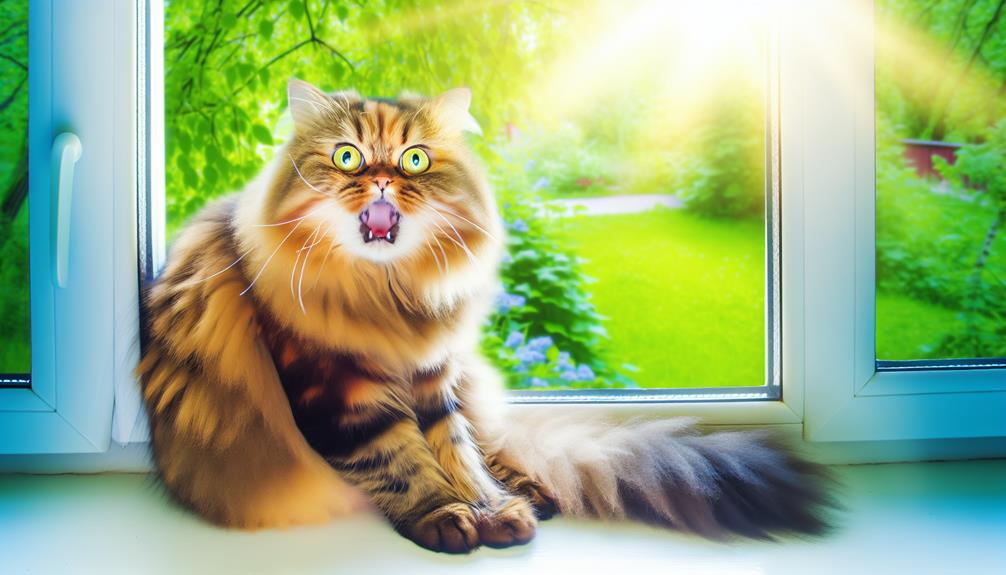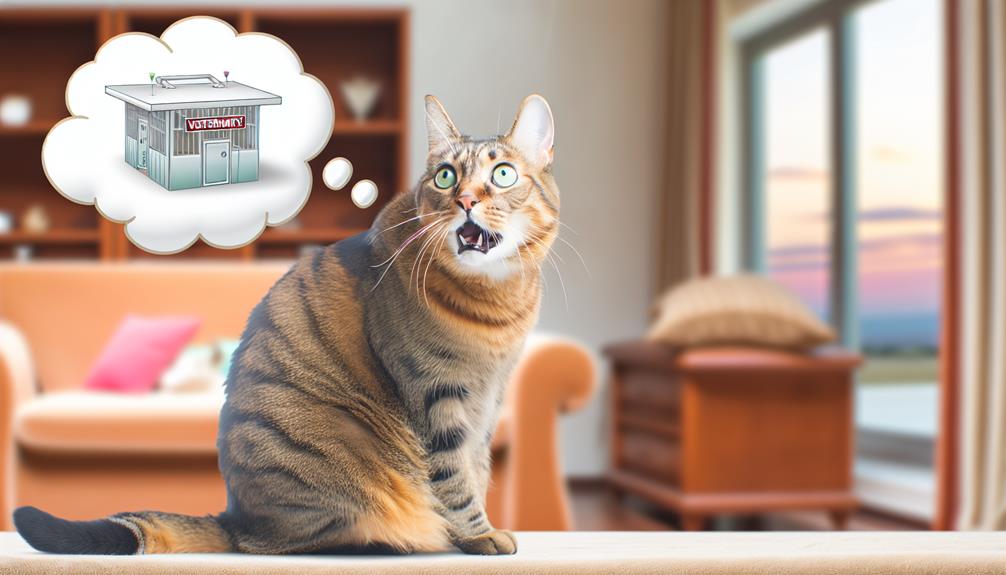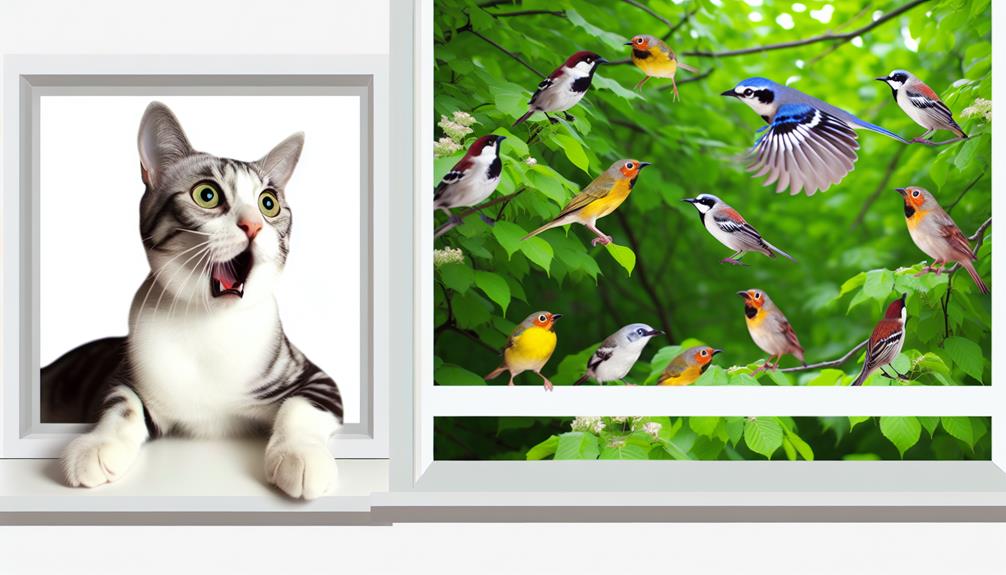When your cat sits by the window and chirps at birds, it's both endearing and puzzling. This vocalization might seem out of place indoors, but it's deeply rooted in their natural hunting instincts. Chirping is more than a quirky habit; it's a complex form of communication that serves multiple purposes. Beyond hunting, cats use these sounds to interact with other felines, express excitement, and even seek your attention. Understanding why your cat chirps can reveal new insights into their behavior and well-being. Curious about what your cat's chirps are really saying?
Natural Hunting Instincts
A cat's chirping behavior often stems from its natural hunting instincts, a trait deeply embedded in its DNA. When your cat chirps, it's tapping into an ancient survival mechanism honed through millennia of evolution. This vocalization is typically observed when a cat sights potential prey, such as birds or small rodents, but can't immediately engage in the hunt due to a physical barrier like a window.
In understanding this behavior, it's essential to take into account feline evolution. Cats, as obligate carnivores, have evolved to be proficient hunters. Chirping may serve as a reflexive response to the excitement and frustration of spotting prey. The chirp could be an attempt to mimic the sounds of birds, thereby luring them closer. This hypothesis aligns with the broader context of hunting behavior where stealth and deception play pivotal roles.
Furthermore, the neural mechanisms involved in this behavior are worth noting. The act of chirping likely engages parts of the cat's brain associated with hunting, including the motor cortex and sensory neurons. These areas are responsible for both the physical actions required during a hunt and the processing of sensory stimuli, such as visual tracking of prey.
Your cat's chirping is not merely a random noise but an expression of its predatory nature. This behavior underscores the intricate balance of sensory perception, motor skills, and evolutionary adaptation that characterizes feline hunting behavior. Observing these behaviors can provide valuable insights into the complex interplay between a cat's instinctual drives and its environmental interactions. Understanding this helps explain why your domesticated cat retains such vivid echoes of its wild ancestors.
Communication With Other Cats
Beyond their interactions with potential prey, cats also use vocalizations like chirping to communicate with other felines. This type of vocalization is an essential component of their intricate social hierarchy and serves multiple functions within group dynamics. Understanding these vocalization patterns can give you insight into the complex world of feline communication.
- Establishing Social Hierarchy: Chirping can serve as a method for cats to establish and maintain their position within a social hierarchy. It's not unusual for subordinate cats to chirp to higher-ranking cats as a form of appeasement. This vocalization, accompanied by specific feline body language, helps to mitigate potential conflicts by signaling submission.
- Territorial Signals: Cats are inherently territorial animals. Chirping can be a non-aggressive way to assert territory, especially in multi-cat households. These vocalizations often occur during interspecies interactions, such as when new cats are introduced into a household. The chirping serves as an auditory marker that complements other territorial signals like scent marking.
- Playful Behaviors and Stress Indicators: Chirping is not solely confined to serious or territorial contexts; it can also be a part of playful behaviors. When cats engage in play, chirping may occur as an expression of excitement or to invite another cat to join in the activity. Conversely, chirping can also indicate stress, particularly if the vocalization becomes more frequent or intense, signaling that the cat may be experiencing discomfort or anxiety.
Expressing Excitement

When your cat starts chirping, it's often an auditory expression of excitement, typically seen during playtime or upon spotting potential prey. This vocalization is characterized by a series of high-pitched, repetitive sounds that indicate heightened stimulation. Understanding this behavior can provide insights into your cat's emotional state and natural hunting instincts.
Anticipating Playtime
Observing your cat's behavior, you may notice a distinctive chirping sound that signifies their anticipation for playtime. This vocalization is a key playtime cue, indicating your cat's excitement and readiness for interactive activities. Chirping, often accompanied by purring or trilling, is a part of feline behavior that serves to engage their human companions and initiate play.
Understanding why your cat chirps during these moments involves recognizing several behavioral indicators:
- Body Language: Cats may exhibit an alert posture with ears perked, tail twitching, and pupils dilated, all of which are signs of heightened arousal and enthusiasm for play.
- Vocalization Patterns: The chirping sound is usually higher-pitched and more repetitive than their typical meows, which helps to capture your attention and communicate their playful intentions.
- Playful Movements: You might notice your cat performing sudden bursts of activity, such as sprinting or pouncing, as part of their anticipatory behavior.
These playtime cues are essential for maintaining your cat's physical and mental well-being. Engaging in regular play sessions not only satisfies their natural predatory instincts but also strengthens the bond between you and your feline companion. Recognizing and responding to these chirping sounds can lead to a more enriched and joyful relationship with your cat.
Spotting Prey
Amidst the myriad of feline vocalizations, chirping often emerges when your cat spots potential prey, such as a bird outside the window. This behavior is deeply rooted in their predatory instincts. When a cat engages in prey recognition, it identifies the potential target through acute visual tracking. Their eyes lock onto the moving object, and their body may become tense, preparing for a potential pounce.
The chirping sound is a manifestation of excitement and frustration. Your cat's brain is processing the visual stimuli rapidly, and the chirp is believed to be a response to the anticipation of capturing the prey. This vocalization might mimic the cat's innate hunting techniques, possibly serving as a form of communication or even practice for the final attack.
The physiological aspect involves the activation of various neural pathways linked to predatory behavior. The auditory cortex processes the chirping sound, while the visual cortex is intensely engaged in tracking the prey's movements. Understanding this behavior can provide insights into your cat's mental and emotional states, emphasizing their natural hunting instincts. Recognizing such signs can enhance your interaction with your feline companion and cater to their predatory needs better.
Mimicking Prey Sounds
Although it might seem peculiar at first, cats often engage in a behavior known as "chirping" or "chattering," which is believed to be an attempt to mimic the sounds of their prey. This vocalization, characterized by rapid, repetitive sounds and a slightly open mouth, is frequently observed when a cat is fixated on birds, rodents, or insects. The purpose of this chirping behavior is still under scientific investigation, but it's widely thought to be a form of prey mimicry aimed at confusing or luring potential prey closer.
Chirp variations among cats can be quite diverse. Some cats produce a high-pitched, almost bird-like trill, while others emit a lower, more guttural chatter. These variations can depend on factors such as the type of prey being targeted, the individual cat's vocal range, and even the environmental context. Understanding these variations can offer valuable insights into feline predatory behavior and communication strategies.
Here are three insights into why cats might mimic prey sounds:
- Instinctual Hunting Behavior: Chirping could be an inherent behavior linked to a cat's predatory instincts, aimed at replicating the sounds of their prey to create a deceptive auditory environment.
- Neurological Stimulation: This vocalization might stimulate the cat's brain similarly to actual hunting, providing mental enrichment and reinforcing predatory patterns.
- Behavioral Conditioning: Over time, cats may learn that certain sounds elicit specific responses from their prey, refining their chirps to increase hunting success.
Seeking Attention

In many instances, a cat's chirping or chattering may also be a behavior aimed at seeking attention from their human companions. This form of vocalization can be especially prominent in felines that have developed a strong bond with their owners. When cats engage in attention-seeking behaviors, they often utilize a range of vocalization patterns, including meowing, purring, and, importantly, chirping. These vocal expressions serve as a communicative bridge between the feline and their human, attempting to initiate interaction or fulfill a specific need.
Cats are known for their complex vocal repertoire, and chirping can sometimes be a strategic choice designed to capture attention more effectively than other forms of vocalization. The high-pitched, intermittent nature of chirps can be particularly effective at engaging human attention, prompting an immediate response. This contrasts with the more continuous and often ignorable sound of a meow. Attention-seeking chirping can be a cat's way of signaling various needs or desires, such as hunger, a desire for play, or simply the need for companionship.
From a medical perspective, it's essential to recognize that persistent attention-seeking vocalizations might sometimes indicate underlying issues, such as anxiety or discomfort. Veterinary professionals often advise monitoring the frequency and context of such behaviors to discern whether they fall within normal behavioral patterns or if they necessitate further investigation. Understanding the nuances of your cat's vocalization patterns can greatly enhance your ability to respond to their needs promptly and appropriately, fostering a more harmonious human-feline relationship. Therefore, chirping serves as an important communicative tool for cats to effectively capture human attention and express their needs.
Maternal Behavior
When observing maternal behavior in cats, you'll notice that chirping serves as a key form of instinctual communication. This vocalization helps mothers teach essential hunting skills to their kittens, facilitating their development. Additionally, these interactions strengthen the bond between the mother and her offspring, ensuring the kittens' successful socialization and survival.
Instinctual Communication Methods
Cats exhibit a variety of instinctual communication methods, particularly noticeable in maternal behavior, to guarantee the survival and well-being of their offspring. These methods encompass both body language and sound variations, each playing a significant role in facilitating effective communication between the mother and her kittens.
- Body Language: A mother cat uses her body to convey messages. For instance, grooming her kittens not only keeps them clean but also strengthens their bond and provides comfort, reducing stress levels.
- Sound Variations: Chirping is one of many vocalizations a mother cat employs. This specific sound can serve as a call for attention or as a signal to follow her, ensuring the kittens remain close and safe.
- Behavioral Cues: Through behaviors like nudging or positioning herself in specific ways, a mother cat can guide her kittens towards food sources or away from potential dangers.
Understanding these instinctual communication methods is essential for comprehending feline maternal behavior. These strategies are deeply embedded in their genetic makeup, ensuring that even in the absence of human intervention, the kittens have a higher chance of thriving. This intricate system of communication highlights the sophistication of feline maternal instincts.
Teaching Hunting Skills
Observing maternal behavior, one can see the essential role a mother cat plays in teaching her kittens fundamental hunting skills. From a young age, kittens learn chasing behavior and how to harness their innate prey drive under their mother's guidance. The mother cat will often bring back live prey, allowing her offspring to practice catching and subduing it. This process not only hones their physical abilities but also refines their cognitive skills in strategizing and pouncing.
During these sessions, the mother cat may chirp to communicate with her kittens, signaling approval or instructing them to focus. This vocalization aids in reinforcing the behaviors required for successful hunting. The chirping, combined with the demonstration of stalking and chasing techniques, forms a thorough teaching method.
In clinical terms, the mother's actions stimulate the kittens' predatory instincts, enhancing their motor coordination and sensory acuity. The repetitive practice of chasing behavior ingrains these fundamental survival skills, preparing them for independent life. The mother's role is indispensable, as she provides both the model and the motivation for the kittens to develop their prey drive effectively. This maternal instruction is essential in ensuring that the kittens can eventually fend for themselves.
Bonding With Kittens
While a mother cat equips her kittens with the skills they need for hunting, another significant aspect of her role involves fostering a deep emotional bond with her offspring. This bonding is vital for kitten socialization and future behavioral development. The mother cat engages in various nurturing behaviors to establish this connection, which includes grooming, nursing, and vocal communication.
- Grooming: Through regular grooming, the mother cat not only keeps her kittens clean but also stimulates their blood circulation and digestion. This tactile interaction helps solidify the emotional bond and promotes a sense of security.
- Nursing: Beyond providing essential nutrients, nursing offers a comforting touchpoint between the mother and her kittens. This act of feeding is intertwined with purring and kneading, further enhancing the bond.
- Vocal Communication: Chirping, purring, and other vocal cues serve as a means for the mother cat to communicate with her kittens. These sounds can soothe, alert, or guide the kittens, playing a key role in their socialization process.
Understanding these nurturing behaviors offers invaluable insight into the maternal instincts that facilitate a kitten's shift from dependence to independence. By recognizing these behaviors, you can better appreciate the complexity and depth of a mother cat's role in her kittens' lives.
Health Concerns

Understanding the health concerns associated with cats chirping is important for responsible pet ownership. While chirping can be a normal and endearing behavior, it's essential to monitor for any accompanying health issues or behavioral changes that might indicate an underlying problem. Cats may chirp due to excitement or communication, but persistent or unusual chirping could signal distress or medical conditions.
Possible Health Concerns:
| Symptom | Potential Health Issue |
|---|---|
| Excessive chirping | Hyperthyroidism, anxiety |
| Lethargy | Anemia, kidney disease |
| Weight loss | Diabetes, gastrointestinal issues |
| Behavioral changes | Neurological disorders, stress |
| Vocal strain | Upper respiratory infection |
If your cat's chirping is accompanied by other symptoms such as lethargy, weight loss, or vocal strain, it's imperative to consult a veterinarian. These symptoms can indicate conditions like hyperthyroidism or upper respiratory infections, which require timely medical intervention.
Behavioral changes, such as increased aggression or withdrawal, could be a sign of stress or neurological disorders. Monitoring your cat's overall behavior and health is essential in identifying any deviations from their norm.
Moreover, excessive chirping can be a sign of anxiety or frustration, particularly if your cat is unable to access what they're chirping at, such as a bird outside the window. Ensuring a stimulating environment and addressing potential stressors can mitigate these issues.
Conclusion
In sum, your cat's chirping is a symphony of natural instincts and social cues. It's not just a sound; it's a complex behavior rooted in their predatory prowess and communicative needs. Imagine your cat as the maestro of a thousand-piece orchestra, each chirp a note expressing health, excitement, and maternal care. Keep a keen ear on these vocalizations, as sudden changes might signify underlying health issues or environmental stressors requiring prompt attention.
